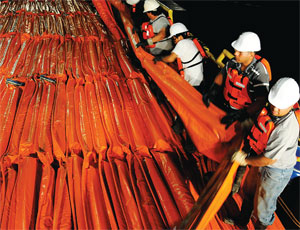Like a hurricane menacing the Gulf Coast, the full damage from the destroyed deepwater oil well in British Petroleum’s Mancando field in the Gulf of Mexico won’t be known for many days. Nor will the cost, now estimated to be in the billions, as offshore crews work tirelessly to keep crude from coming onshore and landside volunteers prepare to begin the massive environmental cleanup. How much is at stake could be read more easily in faces than in financial calculations. “I look in the eyes of fisherman and people making their living on the coast, and you just see fear,” says Bob Thomas, director of the Center for Environmental Communications at Loyola University in New Orleans. “So far we haven’t realized the real damage because it hasn’t come into our marshes.”

BP is spending $6 million a day on cleanup costs and, on May 3, said it was giving coastal states $25 million to begin cleanup efforts. Experts say the cleanup could cost BP $4.5 billion to $6 billion.
The oil leak, coming from 40 miles off Louisiana’s coast, began after an April 20 explosion aboard Transocean’s Deepwater Horizon semisubmersible drilling unit. The explosion occurred when oil and gas from the well, 18,000 ft below the mudline under 5,000 ft of water, reached the surface of the rig and ignited. There were 126 crew members aboard the rig; 11 are still missing and presumed dead, and 17 others were injured. Two days later, a second explosion sank the rig. Although Geneva, Switzerland-based Transocean was operating the rig at the time of the accident, BP is held liable by the U.S. government because it is leasing the oil field.
The leak that is believed to have caused the explosion continues to gush into the Gulf of Mexico, with an estimated 210,000 gal of oil a day coming out at the wellhead and at two spots in a riser pipe that crumpled when the Deepwater collapsed. Doug Suttles, chief operating officer for exploration and production for London-based BP, said on April 30 that estimates of the oil leak were “highly imprecise,” because there is no way to measure the oil coming from the well.
Preliminary reports indicate the accident occurred as Halliburton, based in Houston and Dubai, completed concrete placement around the well bore. The oilfield services contractor confirmed it had completed the final production casing about 20 hours before the incident. The company says it had completed pressure tests to demonstrate the integrity of the casing around the well bore.
Bud Danenberger, former offshore regulatory division chief of the U.S. Minerals Management Service, believes there was some “fundamental problem with the [blowout preventer, or BOP] stack” or a mix of human error and a faulty BOP.
A May 3 report by Robert MacKenzie, an oil-industry market analyst with an engineering background, theorizes that “incomplete isolation by the cement allowed a buildup of annular pressure, which contributed to a casing collapse during a negative pressure test, after which the BOP was unable to seal the well due to an obstruction too thick for the BOP to crush/shear, such as a tool joint of drill pipe.”
Change of Direction
The accident and its aftermath immediately shifted the debate on offshore drilling. The Obama administration said on April 29 the spill could affect its decision to open up new areas to drilling, and on May 3 California Gov. Arnold Schwarzenegger (R) retracted his support for drilling off Santa Barbara.
As crews and onshore volunteers—from Pensacola, Fla., to Port Fourchon, La.—prepared to clean up the oil once...

Post a comment to this article
Report Abusive Comment